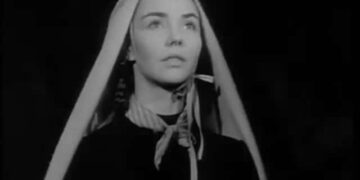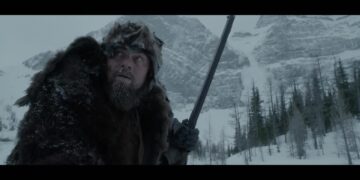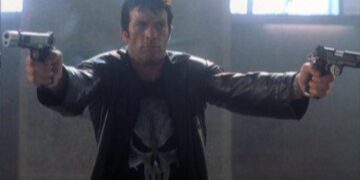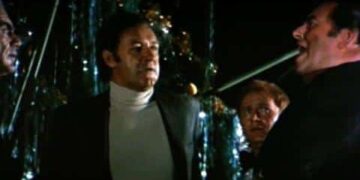The Hulk is an iconic character in both the world of comics and the silver screen. Created by Stan Lee and Jack Kirby, the Green Goliath has captured the imaginations of fans for decades. In this article, we will delve into the fascinating world of the Hulk, comparing and contrasting his portrayal in the comics with Ang Lee’s 2003 film adaptation. From the character’s origins to the film’s soundtrack, we will explore the differences, curiosities, and everything in between. So, let’s dive in and uncover the hidden depths of the Hulk!
Who are Stan Lee and Jack Kirby?
Stan Lee and Jack Kirby are two legendary figures in the comic book industry. Stan Lee, often referred to as the “Father of Marvel Comics,” was the co-creator of numerous beloved characters, including Spider-Man, Iron Man, and, of course, the Hulk. His witty writing and dynamic storytelling revolutionized the comic book medium.
Jack Kirby, on the other hand, was a prolific artist and writer. He collaborated with Stan Lee on many of Marvel’s most iconic characters, co-creating the Hulk alongside Lee. Kirby’s distinctive art style and bold designs brought the Hulk to life on the comic book pages.
Top 5 works by Stan Lee and Jack Kirby
- “The Incredible Hulk” (1962): The debut issue of the Hulk’s standalone series, this comic introduced readers to the gamma-powered alter ego of Dr. Bruce Banner. It set the stage for the character’s enduring popularity.
- “The Fantastic Four” (1961): Lee and Kirby’s groundbreaking superhero team, the Fantastic Four, showcased their unparalleled creativity and storytelling abilities. This comic laid the foundation for the Marvel Universe as we know it today.
- “The X-Men” (1963): Another iconic creation by Lee and Kirby, the X-Men introduced a team of mutant superheroes fighting for a world that fears and hates them. This series explored themes of discrimination and social commentary, making it both entertaining and thought-provoking.
- “Thor” (1962): Lee and Kirby’s take on the Norse god of thunder revitalized the character, bringing him into the modern age. The series introduced the cosmic elements that would later become integral to the Marvel Universe.
- “The Avengers” (1963): Assembling Earth’s mightiest heroes, Lee and Kirby brought together a team of superheroes to face threats too big for any one hero to handle. The Avengers became a cornerstone of the Marvel Universe and spawned multiple successful films.
Who is Hulk in the comics? – A comic character summary
The Hulk, also known as Dr. Bruce Banner, is a complex character in the comics. Created through a gamma radiation experiment gone wrong, Banner transforms into the Hulk whenever he experiences extreme emotions, particularly anger. The Hulk possesses immense strength, making him one of the most powerful beings in the Marvel Universe.
In his comic book adventures, the Hulk battles a wide array of villains, including the Abomination, the Leader, and the Red Hulk. Despite his incredible power, the Hulk often struggles with his own inner turmoil, as Banner constantly fights to control the beast within.
The character’s popularity can be attributed to his relatability. The Hulk represents the darker side of humanity, the uncontrollable rage and power that lies within us all. Through the Hulk, readers can explore themes of identity, anger management, and the consequences of unchecked power.
Ang Lee’s 2003 Hulk film – A movie summary
In 2003, director Ang Lee brought the Hulk to the silver screen in a bold and ambitious film adaptation. Starring Eric Bana as Bruce Banner and Jennifer Connelly as Betty Ross, the film delved into the psychological aspects of the character, exploring his traumatic childhood and the effects of repressed memories.
Lee’s film took a more introspective approach, focusing on the inner struggles of the character rather than bombastic action sequences. The film’s nonlinear narrative and artistic visual style set it apart from traditional superhero films of the time.
Despite its unique vision, the film received mixed reviews from both critics and audiences. While some praised its psychological depth and visual flair, others found it slow-paced and disjointed. Nevertheless, Ang Lee’s “Hulk” remains a significant entry in the character’s cinematic history.
When and where: Hulk’s timeline and film locations
The Hulk’s timeline in the comics is a vast and intricate web of stories spanning several decades. From his early appearances in “The Incredible Hulk” to his involvement in major comic book events, such as “World War Hulk” and “Planet Hulk,” the character has undergone numerous transformations and story arcs.
In the film adaptation, Ang Lee’s “Hulk” takes place in a contemporary setting, with no specific timeline connection to the comics. The film primarily unfolds in two main locations: California and the desert. California serves as the backdrop for Bruce Banner’s everyday life, while the desert becomes the setting for the explosive showdown between the Hulk and his adversaries.
The different timelines and settings between the comics and the film highlight the creative liberties taken by the filmmakers. While the comic book medium allows for ongoing narratives and character development, the film adaptation condensed the story into a standalone experience.
Who’s Who in Hulk: Characters Comparison between Comics and Film
In both the comics and the film, the Hulk is the central character, representing the dual nature of Bruce Banner. However, there are several notable differences in the supporting cast between the two mediums.
In the comics, Betty Ross, the daughter of General Thaddeus “Thunderbolt” Ross, plays a significant role as Bruce Banner’s love interest. She has a complex relationship with the Hulk, torn between her feelings for Banner and her fear of the uncontrollable monster within him.
In Ang Lee’s film, Betty Ross is portrayed as a scientist and Bruce Banner’s ex-girlfriend. The film explores their tumultuous past and the lingering emotional connection between them. Betty serves as a grounding force for Bruce, providing emotional support and understanding throughout his journey.
Another key character in the comics is General Thaddeus “Thunderbolt” Ross, Betty’s father and a recurring antagonist for the Hulk. Ross is obsessed with capturing and controlling the Hulk, viewing him as a dangerous threat to national security.
In the film, General Ross is portrayed as a military officer with a complicated relationship with Bruce Banner. While he initially sees the potential of the Hulk as a weapon, he later becomes consumed by his desire to destroy him. This dynamic creates tension and conflict between the characters.
The differences in character portrayals between the comics and the film highlight the various interpretations and storytelling choices made by the creators. Each medium explores different facets of the Hulk’s world, offering unique perspectives on the characters and their relationships.
Iconic quotes from the Hulk comics and film
Quotes have the power to capture the essence of a character or a story. The Hulk is no exception, with several memorable lines that have become iconic in popular culture. Here are a few notable quotes from both the comics and Ang Lee’s film:
- “Hulk smash!” – This simple yet impactful phrase has become synonymous with the Hulk’s destructive power. It perfectly encapsulates the raw strength and unbridled rage of the character.
- “Don’t make me angry. You wouldn’t like me when I’m angry.” – This line, often spoken by Bruce Banner before transforming into the Hulk, emphasizes the importance of managing anger and the consequences of losing control.
- “Puny god.” – In the 2012 film “The Avengers,” the Hulk delivers this line after defeating the villain Loki. It showcases the character’s sense of humor and his ability to overpower even the most formidable opponents.
- “Hulk is the strongest one there is!” – This line from the comics reinforces the Hulk’s status as one of the most powerful beings in the Marvel Universe. It highlights his confidence and self-assuredness.
These quotes, among many others, have left a lasting impact on fans and have become an integral part of the Hulk’s mythos.
Deep dive into the soundtrack by Danny Elfman
The soundtrack of a film plays a crucial role in enhancing the overall cinematic experience. In Ang Lee’s “Hulk,” the music was composed by the renowned Danny Elfman. Known for his evocative and memorable scores, Elfman brought his unique style to the film.
Elfman’s soundtrack for “Hulk” combines orchestral arrangements with electronic elements, creating a hybrid sound that reflects the dual nature of the character. The music is both haunting and powerful, mirroring the inner turmoil and incredible strength of the Hulk.
One standout track from the soundtrack is “Main Titles.” It sets the tone for the film, capturing the essence of the character and establishing a sense of grandeur. The track blends brooding strings and soaring brass, creating a sense of anticipation and drama.
Another notable piece is “Hulk’s Freedom,” which accompanies the Hulk’s transformation sequences. The music builds tension and excitement, perfectly complementing the visual spectacle on screen.
Elfman’s score for “Hulk” received critical acclaim for its unique approach and emotional depth. It remains a standout aspect of the film, enhancing the overall experience and immersing the audience in the world of the Green Goliath.
Curiosities: Fun Facts about Hulk in Comics and Film
The Hulk has a rich history filled with fascinating facts and trivia. Here are some curiosities that highlight the character’s enduring popularity and cultural impact:
- The Hulk’s first appearance was in “The Incredible Hulk” #1, published in 1962. However, the character initially appeared as a gray-skinned creature, with his iconic green color debuting in later issues.
- Lou Ferrigno, a bodybuilder and actor, portrayed the Hulk in the popular 1970s television series. His physicality and imposing presence brought the character to life, making him a beloved figure among fans.
- In the comics, the Hulk’s strength knows almost no bounds. He has been shown lifting mountains, battling gods, and even punching through dimensions.
- The Hulk’s catchphrase, “Hulk smash,” has become a cultural phenomenon, permeating various forms of media and inspiring countless memes and parodies.
- The character’s popularity led to numerous spin-off series and alternate versions of the Hulk, such as the Gray Hulk and the Red Hulk. These variations explored different aspects of the character’s personality and power.
These fun facts offer a glimpse into the wide-reaching impact of the Hulk and his enduring appeal to fans of all ages.
Tips for cosplaying as Bruce Banner and Betty Ross
Cosplaying allows fans to embody their favorite characters and bring them to life. If you’re interested in cosplaying as Bruce Banner or Betty Ross, here are some tips to help you capture their essence:
- Bruce Banner: To cosplay as the brilliant scientist, opt for a clean-cut appearance with neatly styled hair. Dress in casual attire, such as a lab coat over a button-up shirt and slacks. Don’t forget to bring a pair of glasses to complete the look.
- Betty Ross: For Betty’s cosplay, consider a professional yet stylish outfit. Choose a lab coat or a business suit with a blouse. Accessorize with a name tag and a lanyard. Style your hair neatly and keep your makeup natural.
Remember, cosplay is all about having fun and expressing your love for the characters. Put your own spin on the cosplay and embrace your inner Bruce Banner or Betty Ross!
Ang Lee: His life and other notable works
Ang Lee is a Taiwanese-born filmmaker known for his versatility and artistic vision. Born on October 23, 1954, in Pingtung, Taiwan, Lee began his filmmaking career in the late 1980s. He gained international recognition with his 1995 film “Sense and Sensibility,” which earned him an Academy Award nomination for Best Director.
Throughout his career, Lee has explored various genres and themes, showcasing his ability to tackle diverse subject matters. Some of his notable works include:
- “Crouching Tiger, Hidden Dragon” (2000): This martial arts epic garnered critical acclaim and multiple Academy Awards. It showcased Lee’s mastery of visual storytelling and his ability to blend action with emotional depth.
- “Brokeback Mountain” (2005): A groundbreaking film exploring a forbidden love affair between two cowboys, this drama earned Lee an Academy Award for Best Director. It was praised for its sensitive portrayal of complex emotions and societal taboos.
- “Life of Pi” (2012): Based on the bestselling novel by Yann Martel, this visually stunning film tells the story of a young man stranded at sea with a Bengal tiger. Lee’s direction earned him another Academy Award for Best Director.
Lee’s unique perspective and artistic sensibility make him a compelling filmmaker. His willingness to take risks and push boundaries has resulted in captivating and thought-provoking cinema.
Similarities and Differences: Hulk and other media by Ang Lee
While Ang Lee’s “Hulk” stands as a unique entry in the superhero film genre, it shares similarities and differences with other films in Lee’s filmography. Let’s explore these connections:
- “Crouching Tiger, Hidden Dragon” and “Hulk”: Both films showcase Lee’s visual flair and his ability to intertwine emotional depth with action sequences. While “Crouching Tiger, Hidden Dragon” explores martial arts in a fantastical setting, “Hulk” delves into the psychological aspects of a superhero.
- “Brokeback Mountain” and “Hulk”: Both films tackle complex emotions and societal expectations. While “Brokeback Mountain” delves into the forbidden love between two men, “Hulk” explores the internal struggle of a man battling his own inner demons.
- “Life of Pi” and “Hulk”: Both films delve into themes of identity and self-discovery. “Life of Pi” explores the journey of a young man stranded at sea, while “Hulk” examines the transformation of Bruce Banner into the Hulk and his search for acceptance.
These similarities highlight Lee’s ability to infuse his films with emotional depth and explore universal themes. At the same time, the differences between these films showcase his versatility as a director and his willingness to experiment with different genres and storytelling techniques.
Other Media Similar to the Hulk Plot
The Hulk, a beloved comic character created by Stan Lee and Jack Kirby, has captivated audiences for decades with his incredible strength and struggle for control. While many are familiar with the iconic green behemoth from the Marvel comics, there have been various adaptations of the character in other forms of media. From animated series to video games, the Hulk has been portrayed in different ways, each offering a unique perspective on the character and his story.
One notable adaptation is the 2003 film directed by Ang Lee. This movie takes a more introspective approach, delving into the psychological aspects of the Hulk’s alter ego, Bruce Banner. The film explores the emotional turmoil and inner conflict that Banner experiences, providing a deeper understanding of the character’s struggles. While the comic books often focus on the Hulk’s physical battles, the film offers a more nuanced exploration of the character’s psyche.
Other Works by Stan Lee and Jack Kirby
Stan Lee and Jack Kirby, the brilliant minds behind the creation of the Hulk, have contributed immensely to the world of comics. Their collaboration has resulted in a vast array of memorable characters and storylines, cementing their place in comic book history. Apart from the Hulk, they have created numerous other iconic superheroes, such as Spider-Man, Iron Man, and the X-Men.
Some of their best works include “The Amazing Spider-Man,” which introduced the world to Peter Parker and his web-slinging adventures, and “Fantastic Four,” a groundbreaking series that redefined superhero teams. Additionally, “Thor” and “The Avengers” showcased their ability to create captivating stories that keep readers engaged and invested in the characters. These works demonstrate the incredible creativity and storytelling prowess of Lee and Kirby, solidifying their status as legends in the comic book industry.
Hulk Ending Explained: Comics vs. Film
One of the most significant differences between the Hulk comics and Ang Lee’s 2003 film lies in the portrayal of the ending. In the comics, the Hulk’s story continues to evolve and unfold over the years, with various arcs exploring different aspects of the character. The film, on the other hand, offers a more definitive conclusion to the story, providing closure to the narrative.
In the comics, the Hulk’s story often ends on a cliffhanger, leaving readers eager for the next installment. This allows for ongoing character development and the exploration of new storylines. The film, however, wraps up the narrative neatly, providing a resolution to the conflicts faced by Bruce Banner and the Hulk. While some fans may prefer the open-ended nature of the comics, others appreciate the closure and sense of finality offered by the film’s ending.
Speculations on Remakes, Sequels, and Spin-Offs
With the success of the Hulk comics and the 2003 film, it’s natural to wonder about the possibility of remakes, sequels, and spin-offs. The Hulk’s popularity has endured over the years, making him a prime candidate for further exploration in various mediums.
Given the advancements in technology and the ever-expanding Marvel Cinematic Universe, it’s plausible to expect future adaptations of the Hulk that further delve into the character’s complex nature. Perhaps we may see a modern retelling of the Hulk’s origin story or an exploration of his interactions with other superheroes. The possibilities are endless, and fans eagerly anticipate what the future holds for the green goliath.
Book Club Questions on Hulk Comics and Film
For those who want to delve deeper into the world of the Hulk, whether it be the comics or the film, here are some book club questions to spark discussion and exploration:
- How does the portrayal of the Hulk in the comics differ from the film? Which version do you prefer and why?
- What are some of the underlying themes explored in the Hulk comics and the film? How do they contribute to the overall narrative?
- Discuss the character development of Bruce Banner throughout the comics and the film. How does his struggle with his alter ego shape his journey?
- What impact do you think the Hulk has had on popular culture? How has he influenced the superhero genre as a whole?
- If you could change one thing about the Hulk comics or the film, what would it be and why?
These questions provide a starting point for in-depth conversations about the Hulk and his various adaptations. Whether you’re a long-time fan or new to the character, exploring these questions can offer fresh perspectives and insights.
Conclusion
The Hulk, a comic character with incredible strength and a complex inner struggle, has been brought to life in various forms of media, including Ang Lee’s 2003 film. While the comics and the film offer different interpretations of the character, each brings its own unique elements to the table.
From the creative minds of Stan Lee and Jack Kirby to the cinematic vision of Ang Lee, the Hulk’s journey continues to captivate audiences. Whether you’re a fan of the comics, the film, or both, the Hulk’s story is one that has left an indelible mark on popular culture.
As we eagerly await future adaptations and explorations of the character, let us celebrate the enduring legacy of the Hulk and his incredible journey from paper to silver screen.













